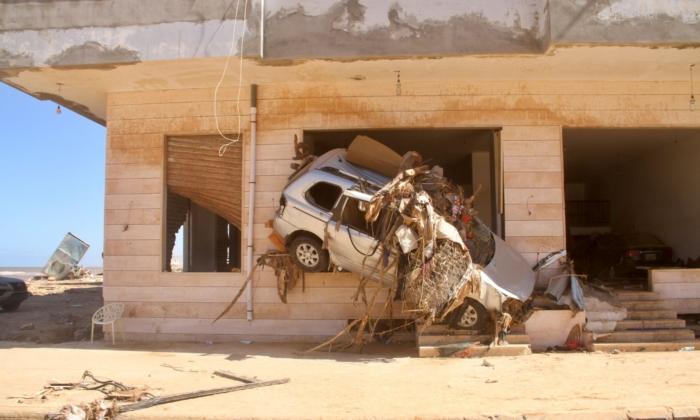DERNA, Libya—The Libyan city of Derna has buried thousands of people in mass graves, officials said Thursday, as search teams scoured ruins left by devastating floods and the city’s mayor said the death toll could triple.
The deluge swept away entire families on Sunday night and exposed vulnerabilities in the oil-rich country that has been mired in conflict since a 2011 uprising that toppled long-ruling dictator Moammar Gadhafi. Health officials have confirmed 5,500 deaths and say 9,000 people are still missing.
What Happened in Libya?
Daniel, an unusually strong Mediterranean storm, caused deadly flooding in towns across eastern Libya, but the worst-hit was Derna. As the storm pounded the coast Sunday night, residents said they heard loud explosions when two dams outside the city collapsed. Floodwaters washed down Wadi Derna, a valley that cuts through the city, crashing through buildings and washing people out to sea.A U.N. official said Thursday that most casualties could have been avoided.
“If there would have been a normal operating meteorological service, they could have issued the warnings,“ World Meteorological Organization head Petteri Taalas told reporters in Geneva. ”The emergency management authorities would have been able to carry out the evacuation.”
The WMO said earlier this week that the National Meteorological Center had issued warnings 72 hours before the flooding, notifying all governmental authorities by email and through media.
Officials in eastern Libya warned the public about the coming storm but did not suggest the dams could collapse or present an evacuation plan.

How Does Conflict in Libya Affect the Disaster?
The startling devastation reflected the storm’s intensity, but also Libya’s vulnerability. Oil-rich Libya has been divided between rival governments for most of the past decade—one in the east, the other in the capital, Tripoli—and one result has been widespread neglect of infrastructure.The two dams that collapsed outside Derna were built in the 1970s. A report by a state-run audit agency in 2021 said the dams had not been maintained despite the allocation of more than 2 million euros for that purpose in 2012 and 2013.
Libya’s Tripoli-based Prime Minister Abdul Hamid Dbeibah acknowledged the maintenance issues in a Cabinet meeting Thursday and called on the Public Prosecutor to open an urgent investigation into the dams’ collapse.
The disaster brought a rare moment of unity, as government agencies across the country rushed to help the affected areas.
What’s Happening Today?
Derna has begun burying its dead, mostly in mass graves, said eastern Libya’s health minister, Othman Abduljaleel.More than 3,000 bodies were buried by Thursday morning, the minister said, while another 2,000 were still being processed. He said most of the dead were buried in mass graves outside Derna, while others were transferred to nearby towns and cities.
Mr. Abduljaleel said rescue teams were still searching wrecked buildings in the city center, and divers were combing the sea off Derna.
Untold numbers could be buried under drifts of mud and debris, including overturned cars and chunks of concrete, that rise up to four meters (13 feet) high. Rescuers have struggled to bring in heavy equipment as the floods washed out or blocked roads leading to the area.

How Many People Have Been Killed?
Health authorities have put the death toll in Derna at 5,500 as of Thursday morning. The number of deaths is likely to climb as searches continue, and at least 9,000 people are still missing, said Ossama Ali, a spokesperson for an ambulance center in eastern Libya.“Some bodies may not be found, especially those who were swept out to sea,” he said.
Local officials suggested that the death toll could be much higher than announced. In comments to the Saudi-owned Al Arabia television station, Derna Mayor Abdel-Moneim al-Ghaithi said the tally could climb to 20,000 given the number of neighborhoods that were washed out.
The storm also killed around 170 people in other parts of eastern Libya, including the towns of Bayda, Susa, Um Razaz and Marj, the health minister said.
Is Help Reaching Survivors?
The floods have also displaced at least 30,000 people in Derna, according to the U.N.’s International Organization for Migration, and several thousand others were forced to leave their homes in other eastern towns, it said.The floods damaged or destroyed many access roads to Derna, hampering the arrival of international rescue teams and humanitarian assistance. Local authorities were able to clear some routes, and over the past 48 hours humanitarian convoys have been able to enter the city.
The International Committee of the Red Cross said Thursday it has provided 6,000 body bags to local authorities, as well as medical, food, and other supplies distributed to hard-hit communities. The U.N. Office for the Coordination of Humanitarian Affairs has released $10 million in emergency funds and is appealing for additional support.
International aid started to arrive earlier this week in Benghazi, 250 kilometers (150 miles) west of Derna. Neighboring Egypt, Algeria, and Tunisia have sent rescue teams and aid, as did Turkey, Italy, and the United Arab Emirates. The U.K. and Germany have also sent supplies.
President Joe Biden said the United States would send money to relief organizations and coordinate with Libyan authorities and the United Nations to provide additional support.







